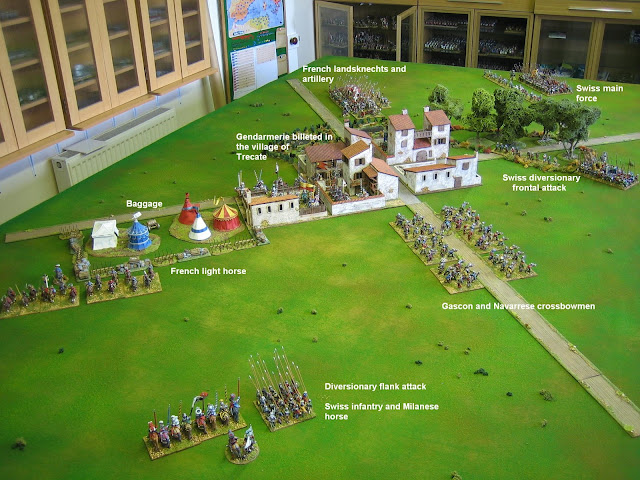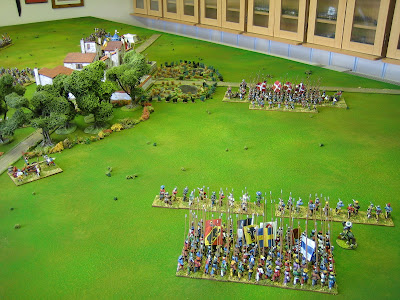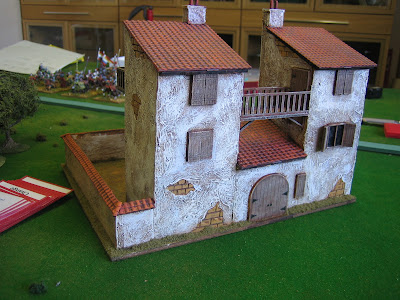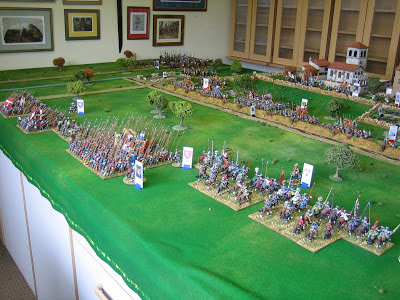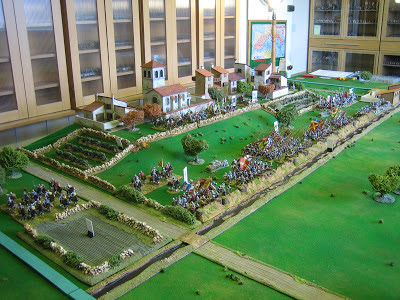We have been slaughtering the Swiss in our Cerignola 1503 game for months. That just isn't fair. So for this week's game I have set up what might be described as the last great victory of the Swiss - Novara 1513.
The battle, simply described, is a surprise attack by the Swiss, at dawn, on an unfortified, and unsuspecting, enemy (French) camp. This is typically Swiss, but the numbers of Swiss in each of their three manoeuvre groups was at variance with their usual tactics: instead of three equal squares they used one of 1000, one of 2000, and one of 7000.
I have used Oman as my primary source and I have deployed the Swiss, on table, in their positions just after the clash of the Swiss diversionary frontal attack on the village of Trecate between Swiss 'enfants perdus' and French pickets. The French C-in-C, partly dressed and armed, has narrowly escaped capture by leaving his billet through the back door. The alarm has been sounded!
Because the Swiss attacked in their traditional formation of three pike squares in echelon, this has put the leading square, along with the Duke of Milan's cavalry, well behind the flank of the French encampment. This is the only position that makes sense. Oman says that they passed by Trecate in the dark, using local guides, and attacked the baggage park that lay beyond. The space this deployment requires is the reason why the on-table deployments have not been laid 'square'.
With a big scoop of fudge, figure scale is about 1:50. Here are some closer shots of the different parts of the action.
We will fight this action on Wednesday night. It is not a big battle, and the nature of terrain (lack of it, for the most part) should make it a pacey affair.
Friday, 29 March 2013
Saturday, 23 March 2013
Another batch of gendarme types
As followers will know, I recently painted up 24 wargames Foundry men-at arms for my Italian Wars collection. I think the heavy cavalry for this period is fantastic, so I don't mind spending a little time making them look a bit special. This brings my men-at-arms numbers up to 15 units (120 figures).
Here is a reminder of that first batch.
It was the first batch of two planned batches. They would be mixed together for plenty of variation in colour and pattern.
http://olicanalad.blogspot.co.uk/2013/02/newly-recruited-gendarme-types.html
This week I finished batch two, and I based them up today. Here are both batches together.
I also included a couple of extra figures for men-at-arms command stands.
The batch was 26 figures in total.
I decided to carry on with the 'geometric pattern' approach in an effort to save time.
This was important as the second batch had twice as many figures riding barded horses!
As well as using the usual stripes, quarters and checks, I decided to pinch a a simple geometric petal design that I have used previously used on 'eastern / oriental' cavalry. It worked well, and was easy peasy to do once I worked out where to put the first 'flower' - mid top back, and front boss.
Below are some close ups of some of the more interesting figures in batch two. During the basing process (in the drying times) I painted up five new cavalry standards. These are all interchangable of course - they are on 3/32 tubing slotted over 0.047 gauge piano wire 'poles'.
http://olicanalad.blogspot.co.uk/2010/07/top-tip-flags.html




Here is a reminder of that first batch.
It was the first batch of two planned batches. They would be mixed together for plenty of variation in colour and pattern.
http://olicanalad.blogspot.co.uk/2013/02/newly-recruited-gendarme-types.html
This week I finished batch two, and I based them up today. Here are both batches together.
I also included a couple of extra figures for men-at-arms command stands.
The batch was 26 figures in total.
I decided to carry on with the 'geometric pattern' approach in an effort to save time.
This was important as the second batch had twice as many figures riding barded horses!
As well as using the usual stripes, quarters and checks, I decided to pinch a a simple geometric petal design that I have used previously used on 'eastern / oriental' cavalry. It worked well, and was easy peasy to do once I worked out where to put the first 'flower' - mid top back, and front boss.
Below are some close ups of some of the more interesting figures in batch two. During the basing process (in the drying times) I painted up five new cavalry standards. These are all interchangable of course - they are on 3/32 tubing slotted over 0.047 gauge piano wire 'poles'.
http://olicanalad.blogspot.co.uk/2010/07/top-tip-flags.html




Thursday, 21 March 2013
Making generic earthworks
The Cerignola game stuff is nearing completion; even the last of the Gendarme types are almost finished. One job I was not looking forward to, was making 12" of earthworks to add to the ones I already have. Making them is not a problem, as they are easy enough to construct. But, I'm adding them to ones I've had for a while and I have to make the old and new blend in. This is never easy: I tend to use cheaply bought (heavily discounted) artists acrylics and odds and sods household emulsions for terrain, and when used up it gets replaced with something similar but, not usually the same.
Anyway, I have taken a few shots of my 'generic earthworks' to show how I made them. They are easy to construct and they are also quite cheap - which puts them into the scope of most gamers.
Firstly, making 12" of earthwork seemed a bit silly. Earthworks are so quick and simple to construct that you might as well make a batch of pieces. I had 16 resin gabions in the locker, so I laid them out next to a tape measure and worked out the length of earthwork I could manufacture from them. It worked out at 36 inches (3 'long' sections).
This is a lot of earthwork for 16 gabions - but I cheat the cost.
After gluing the gabions back towards one edge (see pic above), singly and in pairs, to a strip of 2mm MDF (35mm wide), I cheat the cost by gluing a piece of card in the space between the gabions.
Note: The wide side of the MDF strip will be the front of the earthwork and the narrow side will be the back (defender's) side.
Note: Each strip starts and ends with a gabion. They make the section joins 'disappear'.
To the back (defender's) side of the card I stick horizontally laid lengths of wooded barbecue skewers. (I cut the skewer to length with wire snips). Then I add some vertical 'holding posts'. This is where the cost savings are made - wooden skewers and card are as cheap as chips and look perfectly acceptable as 'barricade' when finished.
At this point I undercoated everything with dark brown artists acrylic.
Next I added the 'earth' to the front of the breastwork. For this I used terracotta Daz modelling clay. It air drys, doesn't shrink much (hardly at all), is strong and durable when set, and is cheap - I used half a 500g pack that I picked up, from ebay, for £3 including postage for this job.
Once dry I used PVA to texture the clay with sand and grit.
 Then I painted the lot with acrylics, acrylic ink, and household emulsions. I added a few patches of flock for more texture and colour - Bob's your uncle, 3 foot of generic 16th to mid 19th Century earthworks.
Getting them to match with the old sections - 8 out of 10? Perhaps I'll leave you to be the judge. BTW, the mid section is the old stuff.
Then I painted the lot with acrylics, acrylic ink, and household emulsions. I added a few patches of flock for more texture and colour - Bob's your uncle, 3 foot of generic 16th to mid 19th Century earthworks.
Getting them to match with the old sections - 8 out of 10? Perhaps I'll leave you to be the judge. BTW, the mid section is the old stuff.
There is another difference between old and new that will not be immediately apparent. The basing uses a different material - the old basing is perspex from an old shower screen, alas, now all used up. Old shower screen, now, those were the days......
Anyway, I have taken a few shots of my 'generic earthworks' to show how I made them. They are easy to construct and they are also quite cheap - which puts them into the scope of most gamers.
This is a lot of earthwork for 16 gabions - but I cheat the cost.
After gluing the gabions back towards one edge (see pic above), singly and in pairs, to a strip of 2mm MDF (35mm wide), I cheat the cost by gluing a piece of card in the space between the gabions.
Note: The wide side of the MDF strip will be the front of the earthwork and the narrow side will be the back (defender's) side.
Note: Each strip starts and ends with a gabion. They make the section joins 'disappear'.
To the back (defender's) side of the card I stick horizontally laid lengths of wooded barbecue skewers. (I cut the skewer to length with wire snips). Then I add some vertical 'holding posts'. This is where the cost savings are made - wooden skewers and card are as cheap as chips and look perfectly acceptable as 'barricade' when finished.
At this point I undercoated everything with dark brown artists acrylic.
Once dry I used PVA to texture the clay with sand and grit.
 Then I painted the lot with acrylics, acrylic ink, and household emulsions. I added a few patches of flock for more texture and colour - Bob's your uncle, 3 foot of generic 16th to mid 19th Century earthworks.
Then I painted the lot with acrylics, acrylic ink, and household emulsions. I added a few patches of flock for more texture and colour - Bob's your uncle, 3 foot of generic 16th to mid 19th Century earthworks.There is another difference between old and new that will not be immediately apparent. The basing uses a different material - the old basing is perspex from an old shower screen, alas, now all used up. Old shower screen, now, those were the days......
Thursday, 14 March 2013
A right old dust up
Last night we let Nemours and Cordoba have at it at Cerignola. The battle was closer than some previous re-fights. Although the battle is not over, I shall do a short report at this point.
 The French begin their advance. The Swiss, subjected to early artillery fire are tardy - they were 'vexed' (disordered, etc.) and will move at half speed until rallied.
The French begin their advance. The Swiss, subjected to early artillery fire are tardy - they were 'vexed' (disordered, etc.) and will move at half speed until rallied.
Peter J., in white, is moving D'Alegre's off table rearguard.
 Graham H. helps d'Alegre out from under his elbows - Graham does not like the smell of French garlic (Spanish is fine) - and this was the fastest he moved all night (Graham that is).
Graham H. helps d'Alegre out from under his elbows - Graham does not like the smell of French garlic (Spanish is fine) - and this was the fastest he moved all night (Graham that is).
 D'Ars orders his cavalry across the ditch. The Italian arquebusier are forced back.
D'Ars orders his cavalry across the ditch. The Italian arquebusier are forced back.
 The French infantry and Swiss pike reach the ditch.
The French infantry and Swiss pike reach the ditch.
For this re-fight we deployed the French skirmishers in deep formation blocks, side by side . They will go into multiple lines for the Triples demo.
 The Spanish shot flies thick and fast.
The Spanish shot flies thick and fast.
 Peter J. knows that this is his moment. Graham, unperturbed, looks on. Turn 1 is almost over.
Peter J. knows that this is his moment. Graham, unperturbed, looks on. Turn 1 is almost over.
 D' Alegre's light cavalry arrives, but his heavy horse (in the backgound) is still some way off). It's turn two.
D' Alegre's light cavalry arrives, but his heavy horse (in the backgound) is still some way off). It's turn two.
The orange paper on the road, under the stradiotti, is an arrow showing 'relative entry' point.
 The Swiss force the breastwork.
The Swiss force the breastwork.
 But after a bitter fight, the Landsknechts, supported by volleys of Spanish arquebus, force them back - the Swiss, who started at 14 UI are at 0 UI: They've shot their bolt. Then again, they might be rallied.
But after a bitter fight, the Landsknechts, supported by volleys of Spanish arquebus, force them back - the Swiss, who started at 14 UI are at 0 UI: They've shot their bolt. Then again, they might be rallied.
 D'Ars is also making progress.
D'Ars is also making progress.
 D'Alegre's stradiotti come to grips on the extreme left.
D'Alegre's stradiotti come to grips on the extreme left.
Gespard de Coligny de Chatillon, commander of the French infantry, is dead. We will examine his body after the battle: Was it Spanish ball or French bolt?
 D'Ars is counter attacked by Frabricio Colonna's Italian heavy cavalry and is forced back. It looks like Colonna is planning a left hook.
D'Ars is counter attacked by Frabricio Colonna's Italian heavy cavalry and is forced back. It looks like Colonna is planning a left hook.
 D'Alegre has other ideas, four fresh units of French Gendarmes are heading for the crumbling French right.
D'Alegre has other ideas, four fresh units of French Gendarmes are heading for the crumbling French right.
 We are almost at the end of turn 2 (a turn ended half way through on an equal initiative roll and is not included in the turn count). We have been playing for going on for under 3 hours but, it already looks like another Spanish victory.
We are almost at the end of turn 2 (a turn ended half way through on an equal initiative roll and is not included in the turn count). We have been playing for going on for under 3 hours but, it already looks like another Spanish victory.

Peter J., in white, is moving D'Alegre's off table rearguard.



For this re-fight we deployed the French skirmishers in deep formation blocks, side by side . They will go into multiple lines for the Triples demo.



The orange paper on the road, under the stradiotti, is an arrow showing 'relative entry' point.




Gespard de Coligny de Chatillon, commander of the French infantry, is dead. We will examine his body after the battle: Was it Spanish ball or French bolt?



This last week I have based up the newly painted figures (102 infantry, 40 cavalry). I have also taken a break from painting (my own, but not client's) figures to paint up the two buildings in my spare time. They are a stable, and a balconied residential block. I also took the the opportunity to make a long, free standing, high, wall which now forms part of Cerignola - you can see it in some shots in front of the second pictured building - see the 'D'Ars is counterattacked' shot.
Sunday, 10 March 2013
Cerignola 1503 at 1:20
As regulars will know, this battle has become almost habitual on this blog. I am currently working towards putting on Cerignola 1503, as a demo-game, at Sheffield Triples on 18th / 19th May 2013. Peter and I will be running the game using our house rules, Hell Broke Loose. Because it is going 'out and about', I have decided to make it more of a spectacle by increasing the number of figures involved. It is now scaled at 1 figure to 20 men.
The figures are nearly finished. I have three more units of Foundry men-at-arms to paint (these will replace the units in Gonsalvo's command - currently they are represented by two units of WoR knights and a unit of archer cavalry). When these figures are finished I will have to do 5 cavalry standards - mainly Italian; the 3/32 'flag pole' tubing has been ordered!
Other jobs, still pending, are to finish the two buildings and make a 12" section of earthworks ( I'll probably make several sections with the gabions purchased at Vapnartak) and match it to the existing ones. I also have to lighten the shade of the baize cloth with yellow and caramel spray paint. Yellow is the prime colour for this; two more cans of yellow paint have been ordered!
The main change to the scenario is that D'Alegre, commanding the French rearguard, will start off-table, kinda. Initially, I thought of having him arrive on the second or third turn in a typical 'wargame scenario' way. Then, thinking about the variable move distances in Hell Broke Loose, I decided to have him visibly march to the battlefield; he must physically march across one end of the table before arriving. The white arrows on the deployment map show the exit and entrance points. I like this idea because it should build in more tension, and stuff will not just appear on the table from out of a box.
French Order of Battle
The French [blue] battle line; Louis d'Armagnac, Duke of Nemours, commanding [A].
Louis d'Ars [B]: 3 units of 8 gendarmes, 2 units of mounted crossbows.
Tambien Chandieu [C]: 1 unit of 180 Swiss pike.
Yves d'Alegre [E]: 4 units of 8 gendarmes, 4 units of 8 Stradiots, 4 batteries of 1 gun.
All in column and marching to the battlefield.
Gonsalvo de Cordoba [A]: 3 units of 8 Spanish men-at-arms. (These are the troops that need replacing).
Fabricio Colonna [B]: 3 units of 8 Italian condottiere men-at-arms.
Diego de Paredes [C]: 2 units of 36 Spanish infantry in colonela, 2 units of 16 Italian arquebusier.
Fabricio Zamudio [D]: 1 unit of 90 Landsknecht pike, 1 unit of 12 Landsknecht arquebusier.
Pizarro de Paredes [E]: 2 units of 36 Spanish infantry in colonela, 2 units of 8 Spanish genitors, 1 unit of Italian mounted crossbow.
Pedro Navarro [F]: 2 batteries of 1 gun.
The figures are nearly finished. I have three more units of Foundry men-at-arms to paint (these will replace the units in Gonsalvo's command - currently they are represented by two units of WoR knights and a unit of archer cavalry). When these figures are finished I will have to do 5 cavalry standards - mainly Italian; the 3/32 'flag pole' tubing has been ordered!
Other jobs, still pending, are to finish the two buildings and make a 12" section of earthworks ( I'll probably make several sections with the gabions purchased at Vapnartak) and match it to the existing ones. I also have to lighten the shade of the baize cloth with yellow and caramel spray paint. Yellow is the prime colour for this; two more cans of yellow paint have been ordered!
The main change to the scenario is that D'Alegre, commanding the French rearguard, will start off-table, kinda. Initially, I thought of having him arrive on the second or third turn in a typical 'wargame scenario' way. Then, thinking about the variable move distances in Hell Broke Loose, I decided to have him visibly march to the battlefield; he must physically march across one end of the table before arriving. The white arrows on the deployment map show the exit and entrance points. I like this idea because it should build in more tension, and stuff will not just appear on the table from out of a box.
French Order of Battle
The French [blue] battle line; Louis d'Armagnac, Duke of Nemours, commanding [A].
Louis d'Ars [B]: 3 units of 8 gendarmes, 2 units of mounted crossbows.
Tambien Chandieu [C]: 1 unit of 180 Swiss pike.
Yves d'Alegre [E]: 4 units of 8 gendarmes, 4 units of 8 Stradiots, 4 batteries of 1 gun.
All in column and marching to the battlefield.
Spanish Order of Battle
The Spanish battle line: Gonsalvo de Cordoba [A] commanding.Gonsalvo de Cordoba [A]: 3 units of 8 Spanish men-at-arms. (These are the troops that need replacing).
Fabricio Colonna [B]: 3 units of 8 Italian condottiere men-at-arms.
Diego de Paredes [C]: 2 units of 36 Spanish infantry in colonela, 2 units of 16 Italian arquebusier.
Fabricio Zamudio [D]: 1 unit of 90 Landsknecht pike, 1 unit of 12 Landsknecht arquebusier.
Pizarro de Paredes [E]: 2 units of 36 Spanish infantry in colonela, 2 units of 8 Spanish genitors, 1 unit of Italian mounted crossbow.
Pedro Navarro [F]: 2 batteries of 1 gun.
Subscribe to:
Comments (Atom)

